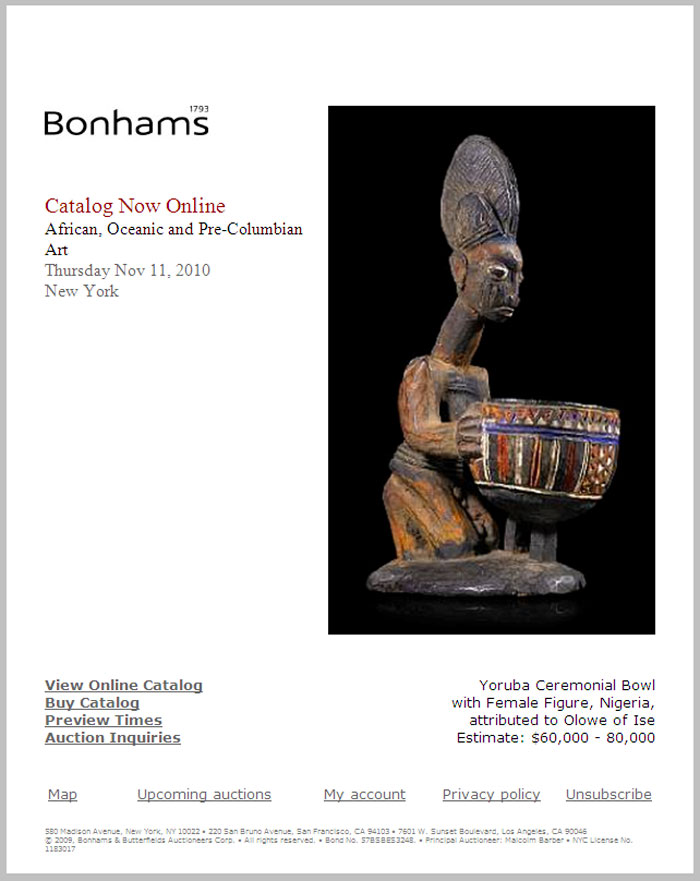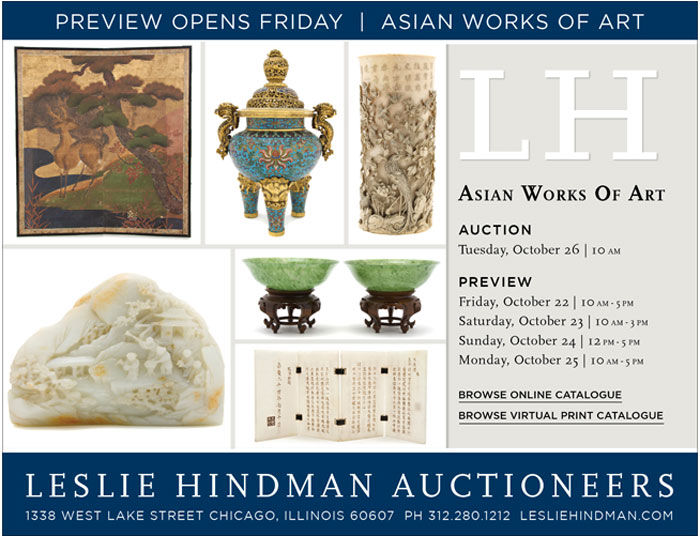Leslie Hindman Auctioneers – Asian Works of Art
October 20th, 2010 by adminAuction: Oct 26th 2010 10:00 am
Preview:
Oct 22nd 2010 10:00 am – 5:00 pm
Oct 23rd 2010 10:00 am – 3:00 pm
Oct 24th 2010 12:00 pm – 5:00 pm
Oct 25th 2010 10:00 am – 5:00 pm
Sotheby’s Contemporary Art Auctions
October 20th, 2010 by adminAntique Helper Dan Ripley’s – Art & Antiques, Mission to Modern & Tribal Art
October 20th, 2010 by adminAuction: Oct 30th 2010 10:00 am
Antique Helper’s October Art and Antiques Auction featuring Mission to Modern will offer a large representation of art and antiques, including furniture, fine and decorative arts and a variety of artifacts. An additional, select grouping of African, Oceanic, Native American and Pre-Columbian art and artifacts, plus Peruvian textiles, will be offered on October 30. These objects have been gathered from several notable collections.
Featured items are on display now and many more will be featured during the week. The catalog will be online by this Friday. Visit www.antiquehelper.com to view catalogue.
Antique Helper Express Auction
October 20th, 2010 by adminAntique Helper announces Antique Helper Express Auctions.
Sales are held on the 2nd & 4th Tuesdays of each month from 10am – 2pm.
Preview images are posted on the preceding Friday for each sale.
(Indianapolis, Indiana) Dan Ripley’s Antique Helper announces a new weekday format for discovery auctions. The focus will be short, four-hour uncataloged sales with an emphasis on furniture and decorative items. The four-hour auction format is a new innovation that Dan Ripley has devised as a means to make the auction experience more attractive to newcomers and those who have limited time on their hands. “It’s a win-win situation,” says Ripley. “People can come to an Express auction, have a good time, bid on quality merchandise and know that the sale has a concrete end time.”
Dan Ripley acknowledges that people with limited schedules don’t always have the time to commit to an all-day sale. Express auctions will be especially attractive to parents with school age children and individuals with little free time. Given Antique Helper’s convenient location, close to Broad Ripple, Meridian Kessler and North side communities, auction goers will have the ability to arrive at a reasonable time and get home before rush hour. “It’s an easy in, easy out kind of auction day,” says Ripley. “The schedule eliminates the stress of waiting to see if the item a buyer wants will come up for bidding before they have to leave to make it for car line or an afternoon appointment.”
Offered as an alternative to grabbing a cup of coffee at a local eatery with friends, Antique Helper Express auctions will offer auction goers the chance to socialize and enjoy coffee and breakfast treats while enjoying the excitement of acquisition. Antique Helper staff hopes to attract a new audience to these sales. “This is a great opportunity for folks who are new to the auction world to get their feet wet and learn about buying at auction in a non-threatening environment,” says Dan Ripley. Adding to the appeal, there will be contests and give-aways, including tickets to Children’s Museum of Indianapolis. “Many people don’t understand what an untapped resource an auction can be,” says Ripley. “Our goal is to get people with families through our door. We hope to educate them and present the opportunity to buy pieces that are both fun and functional.”
“Auctions are a great way to find items to update and upgrade your interior, says Antique Helper staffer and passionate re-decorator, Andrea Hastings. “You can get everything from art for your walls to furniture and dishes.” The Antique Helper Express auctions offer plenty of decorative items, furniture and area rugs. Hastings continues: “Sales formats like this have been a staple in major metropolitan areas for years. Now Indianapolis residents can discover what New York housewives have known for years.”
Antique Helper will hold its first Antique Helper Express Auction on Tuesday, October 12. The doors will open at 9 AM, and the auction will run from 10 AM to 2 PM.. Given the bulk of consignments that come through the doors, Ripley has decided to offer these sales twice monthly, one the second and fourth Tuesdays of each month.
For more information about Antique Helper Express Auctions, visit www.antiquehelper.com.
Antique Helper Dan Ripley’s – Important African, Oceanic and American Tribal Art
October 20th, 2010 by adminAuction: Oct 23rd 2010 10:00 am
Antique Helper will present an important auction of African, Oceanic and Native American art and artifacts on Saturday, October 23rd. Gathered from several distinguished collections, a number of selections from this auction are the subject of scholarly works. Some have been exhibited, and are listed in the Yale archive of traditional African art.
Stefek’s Fall Antique Furniture & Glass Auction
October 20th, 2010 by adminAuction: Oct 28th 2010 6:00 pm
Preview: Oct 22nd, 23rd, 25th – 26th 2010 10:00 am – 4:00 pm — Also Oct 27th from 10:00 am – 8:00 pm
Appraisal Clinic: Oct 27th 2010 10:00 am – 2:00 pm
Auction features a collection of Vitrines, GWTW Lamps, Wave Crest and other decorative glass and porcelain items.
Catalogue available online now.
Sotheby’s – Contemporary Art – Arab & Iranian
October 18th, 2010 by adminOn October 20th, Sotheby’s will present it’s strongest-ever sale of Arab & Iranian Contemporary Art, which not only offers cohesive and representative work by Syrian, Lebonese, and Iraqi modern masters and major pieces by Iranian and Egyptian artists with outstanding provenance, but also showcases an impressive selection of young cutting edge work.
Sotheby’s – Important Russian Art Auctions
October 18th, 2010 by adminThe Inaugural Important Russian Art Auction, November 4th in New York, comprises an exclusive collection of the highest quality works by the greatest names in 20th century Russian Art.
Picking with Reyne Vol. 22: A little picking strategy at auction… Part I
October 18th, 2010 by admin Who says you can only pick door to door? There are plenty of picking opportunities that arise at auction. I know I’ve bought tons of box lots over the years – gave away the dreck and sold the diamonds!
Who says you can only pick door to door? There are plenty of picking opportunities that arise at auction. I know I’ve bought tons of box lots over the years – gave away the dreck and sold the diamonds!
Recently I spoke with my good friend, Martin Willis. Martin is a second generation auctioneer, with 35 years of auction and antique experience under his belt. And he just happens to be a bit of a picker as well. We had a great conversation about one’s ability to make some serious cash picking at auction and it went a little something like this…
Reyne: Martin, you’ve worked for auctions and also had your own auction – is there really money to be made there or does stuff always sell for a retail price?
Martin: First of all, I want to say that I truly believe that there is at least one or many more bargains at every single auction, no exception. I had a client that used to sit in all the New York “big house” auctions back in the 1990s. The focus at these sales were the big-ticket items and he would often buy mid range paintings for a good deal and put them in my auctions and make a very good profit. I would spotlight them versus less attention in the previous sale it was in. For instance, he bought a Polish painting for $500, which I sold for $12,000.
Actually, I have done the same thing. Bid on mid to low tier paintings at Sotheby’s and Christie’s only to sell them at Butterfields for a nice profit. Most people think deals are never found at the big New York houses but that is so not true.
Reyne: What are some strategies you can share that would make my experience a good one?
Martin: The number one rule in buying well at auction is patience coupled with perseverance. Attending in person is the safest way to find a deal. First of all, if you have knowledge in a particular item and have an interest in buying, look around and see if you can find it. For example, say I collect art pottery. Now I will scour the auction for the pottery, catalog in hand. If I find a piece, I make sure it is described and estimated properly. I should say that it usually does not matter how something is estimated, if enough people are aware of the piece, it will seek the correct price. On the other hand, if it is misidentified, you have a chance. There are mistakes in all auction houses; it simply cannot be avoided with the vast amount of property handled.
Good points. You can’t know it all and even with catalogs now hosted online for all the world to see, plenty of things slip through the cracks.
Martin: Next, check out group lots, they are a great way to buy. A piece placed in a group, generally means the cataloger did not think it could stand on its own. If you can find that nice piece of pottery in a group lot, you have a great chance of getting a good deal.
If it is a long auction and your item is coming up toward the end, wait it out. The crowd will trickle down and there will be less competition. When I mentioned before that there is always a deal at an auction, while you wait for your item(s) to come up, you are liable to see a bargain, so be on the lookout. A word of caution, speaking from experience, do not bid on something unless you have looked at it. I have owned a lot of white elephants that looked good from 50 feet away.
I have certainly done that a time or two. You know the artist, you know it’s right but you didn’t personally inspect it to see the 5” crack running down the side….
Reyne: What are other strategies that work?
Martin: My close friend and former partner was hired to bid at an auction house in Illinois on a major period American secretary. Once he carefully inspected it and gave his client a condition report, he had the authority to bid as high as $350,000 on it. Before the auction, he spoke with the auctioneer and said he wanted to bid on the piece, but did not want anyone to know he was bidding. Often people will bid higher on something when a noted expert such as him bids on a piece. He told the auctioneer to look at him when the piece comes up and if his arms are folded, to take his bid. Once he was to drop his arms to his side, he was out. The bidding started at $50,000 and went slowly up to $220,000; my friend was the winning bidder. He said it caused a bit of a stir as everyone else bidding was watching him and wondering who was bidding. They also wondered how whoever it was could be bidding, as they saw nothing going on in the direction the auctioneer was looking in. When the auctioneer said sold, my friend held up his bidder number and there was a bit of grumbling. Now, I am not sure if he got it for less then if he was openly bidding, but I assume he probably did.
I have experienced this too. That’s why I sit at the back of the room, or I leave an absentee bid on things I really want. Then if it goes for more than the bid I left, I can still jump back in and bid more.
Reyne: What is the best strategy you have seen people using at an auction?
Martin: This one may be hard to swallow for a lot of people, but I have seen it work many times. I will just use an example: You are a Tiffany lamp collector and you attend an auction where there is an acorn shade Tiffany lamp. Your maximum bid will be $9,000. When you get there you see everyone you know that will buy the lamp for the same price. Auctioneers generally start something for around half the low estimate, sometimes lower, sometimes higher. Let’s say the auction estimate is $8,000 to high $12,000. The auctioneer asks for an opening bid of $4,000. This is when you hold your card up and shout $7,000! Everyone turns and looks and the auctioneer may stumble and ask for the next increment of $7,250. At this point, often times no one will bid because it throws the whole thing off. If someone bids the $7,250 the auctioneer turns to you asking $7,500 you shout, $8,000! Often times it will be yours at this bid. By doing this, people will know you are serious, and often may think you are a bit nuts, so they will not bid again. I have seen this done with success dozens of times over the years.
Hahaha, I’ve seen people do this and I too thought they were nuts, or the auctioneer was just moving a bit slow and they wanted to hurry up and get to a “real” price.
Reyne: Do you think this negatively affects the sale?
Martin: I don’t think so in my opinion. It would not happen enough at any given sale to cause a problem. However, I did watch quite a phenomenon happen at one time. Back in the day when I used own Seaboard Auction Gallery in Maine, I rented it out to specialty auctioneers when I was not having a sale. There was an auction of painted country antique collectibles such as baskets, Shaker pieces and the like. Attending the auction was the foremost dealer in country pieces sitting in the front row. Right off the bat she bid on the first 30 or so lots of the auction. She just held her card up until she owned each and every item, no matter how high it would go for. I watched dealer after dealer exit the sale in frustration. I don’t know if it was her intention, but she cleared out most of the dealers at the auction and bought a large portion for a very good price. This is a case where I would say the auction was hurt.
Another phenomenon to note: Bargains at auctions often stem from a physiological situation. For instance, a nice piece may come up, well worth all the money and for some unknown reason, no one bids right away; this makes people wonder why no one is bidding, so no one will bid on it at all. If you are sure about the piece, don’t second guess it; throw in a bid just before you think it may pass. You may start everyone bidding, or you may get a great buy.
Reyne: What strategies to buy at auction would you give to the novice?
WAIT WAIT WAIT right there….tune in next week when I post the answers to this question, and several more I had for Martin!
Before you go, make sure to check out Martin’s podcast online:
http://www.antiqueauctionpodcast.com/
Martin brings you the skinny on some of the most important people in the world of antiques each week!








